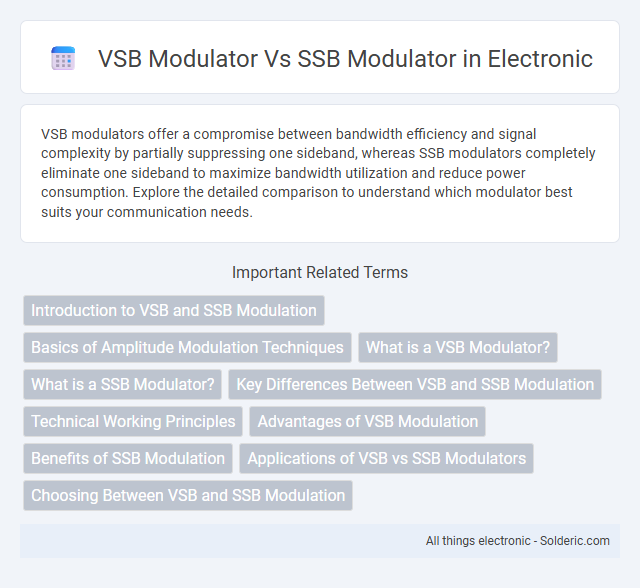VSB modulators offer a compromise between bandwidth efficiency and signal complexity by partially suppressing one sideband, whereas SSB modulators completely eliminate one sideband to maximize bandwidth utilization and reduce power consumption. Explore the detailed comparison to understand which modulator best suits your communication needs.
Comparison Table
| Feature | VSB Modulator (Vestigial Sideband) | SSB Modulator (Single Sideband) |
|---|---|---|
| Sidebands Transmitted | One full sideband + partial vestige of the other | Only one sideband (upper or lower) |
| Bandwidth Efficiency | Moderate (around 75% of DSB bandwidth) | High (approximately 50% of DSB bandwidth) |
| Complexity | Moderate; simpler than SSB, requires vestigial filter | High; requires precise filtering and carrier suppression |
| Applications | TV broadcasting (analog video signals) | HF radio communications, amateur radio, military comms |
| Signal Quality | Good; less susceptible to distortion than DSB | Very good; efficient power and bandwidth utilization |
| Carrier Presence | Carrier partially present | Carrier suppressed or completely removed |
Introduction to VSB and SSB Modulation
Vestigial Sideband (VSB) modulation transmits one full sideband and a partial section of the other, optimizing bandwidth for analog TV broadcast. Single Sideband (SSB) modulation eliminates one sideband entirely, significantly reducing bandwidth and improving power efficiency in voice communication. Both techniques enhance spectral efficiency but serve different applications due to their distinct sideband transmission methods.
Basics of Amplitude Modulation Techniques
VSB modulators transmit a partially suppressed carrier with one full sideband and a vestige of the other, optimizing bandwidth while retaining easier demodulation compared to SSB modulators, which transmit only one sideband with a fully suppressed carrier to maximize spectrum efficiency. VSB modulation balances reduced bandwidth usage and signal robustness, commonly used in television broadcasting, whereas SSB modulation offers narrow bandwidth and power efficiency ideal for long-distance voice communications and amateur radio. Both techniques derive from amplitude modulation principles, manipulating carrier and sidebands to enhance transmission quality and spectral efficiency.
What is a VSB Modulator?
A VSB modulator generates a Vestigial Sideband signal by transmitting one full sideband and a portion of the opposite sideband, optimizing bandwidth efficiency while preserving signal integrity. This modulation technique is widely used in television broadcasting to reduce bandwidth compared to traditional AM, minimizing adjacent channel interference. VSB modulation balances the complexity of filter design with spectral efficiency, making it a practical choice between double sideband and single sideband modulation methods.
What is a SSB Modulator?
A Single Sideband (SSB) modulator efficiently transmits information by suppressing the carrier and one sideband, reducing bandwidth and power usage. Unlike a Vestigial Sideband (VSB) modulator, which partially transmits a portion of the suppressed sideband to facilitate easier demodulation, the SSB modulator offers a cleaner signal spectrum, ideal for long-distance communication. Your choice of an SSB modulator can enhance signal clarity and spectral efficiency in voice and data transmissions.
Key Differences Between VSB and SSB Modulation
VSB (Vestigial Sideband) modulation transmits one full sideband and a partial sideband, optimizing bandwidth and allowing better audio quality in TV broadcasts, while SSB (Single Sideband) modulation eliminates one entire sideband to conserve bandwidth and power, ideal for long-distance voice communication. VSB modulator complexity is higher due to partial sideband transmission and filtering requirements, whereas SSB modulators focus on precise sideband suppression to enhance spectral efficiency. Your choice between VSB and SSB modulators largely depends on the application's bandwidth constraints, signal clarity needs, and transmission distance.
Technical Working Principles
VSB modulators partially suppress one sideband while retaining the carrier and a vestige of the other sideband, enabling easier demodulation compared to SSB modulators that completely eliminate one sideband and the carrier, requiring complex coherent detection. VSB modulation uses filters with gradual roll-off to achieve partial sideband suppression, balancing bandwidth efficiency and signal integrity, whereas SSB modulation employs sharp filtering or phasing methods to isolate a single sideband. The technical working principle of VSB supports broadcast systems like analog TV by minimizing bandwidth while maintaining carrier-based demodulation, contrasting with SSB's emphasis on maximum spectral efficiency for point-to-point communication.
Advantages of VSB Modulation
VSB modulation offers advantages such as improved bandwidth efficiency compared to traditional AM, making it suitable for television broadcasting where partial sideband suppression reduces adjacent channel interference. Your communication system benefits from easier implementation and better noise immunity than SSB modulation, especially in complex signal environments. VSB's balanced trade-off between spectral efficiency and signal quality provides a practical solution for reliable data transmission with minimal distortion.
Benefits of SSB Modulation
SSB modulation offers significant bandwidth efficiency by transmitting only one sideband, which reduces power consumption and minimizes interference compared to VSB modulators that transmit a partial sideband alongside the carrier. The reduced bandwidth usage of SSB allows for clearer signal transmission over long distances and improves overall spectral efficiency in wireless communications. SSB modulators are preferred in applications such as amateur radio and maritime communications due to their superior signal quality and energy conservation.
Applications of VSB vs SSB Modulators
VSB modulators are widely used in television broadcasting, specifically in analog and digital TV transmission standards such as ATSC, because they efficiently balance bandwidth usage and signal quality. SSB modulators find primary applications in HF radio communications, including amateur radio and marine band transmissions, due to their narrow bandwidth and power efficiency that enhance long-distance signal clarity. Each modulation type optimizes performance based on the communication system's bandwidth constraints and signal propagation requirements.
Choosing Between VSB and SSB Modulation
Choosing between VSB (Vestigial Sideband) and SSB (Single Sideband) modulation depends on your application requirements for bandwidth efficiency and signal quality. VSB modulation, commonly used in television broadcasting, offers a compromise by transmitting a full sideband and a vestige of the other, reducing bandwidth while maintaining better signal integrity. SSB modulation provides maximum bandwidth efficiency by transmitting only one sideband, making it ideal for long-distance communication where spectrum conservation and power efficiency are critical.
VSB modulator vs SSB modulator Infographic

 solderic.com
solderic.com